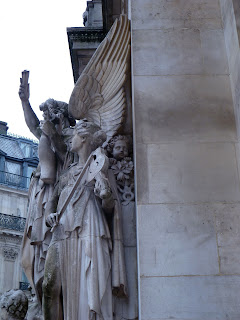I payed my first visit to the Paris Opéra, or Palais Garnier (named after its architect), the other day. Unfortunately, my camera battery died mid-visit so I couldn't take all the shots I wanted, or re-take some of the poorly-lit shots you can see here. But I'll go back...
The building is a total delight. It has often been said that the idea of the Opéra was to put the audience on display in a kind of bourgeois theatricality. Even the little brochure I picked up says, "The Grand Staircase is itself a theatre where, in years gone by, the crinolines of fashionable society ladies would brush." This description certainly works. I get the sense that the unbelievable opulence of the place---every surface of spaces like the Grand Staircase and Grand Foyer (is anything here not "Grand"?) are completely crenelated with decorative carvings, paintings and ornament, to the point that practically no one detail really matters so much as the whole effect---as well as the way the Opéra was clearly influenced by Baroque palaces, were meant to give nineteenth-century theatre-goers the sense that they too were aristocrats, if only for an evening. This is curiously, and often sensuously re-inforced by how the building's monumental architecture is brought down to an individual's scale. Thus small dragons slither up dark corners of the Grand Staircase, if you happen to notice; the extended bronze feet of lamp-holding female figures have been kept polished by generations of hands and evening wear brushing past; the marble balcony railings overlooking the Grand Staircase perfectly curve at the sides to accommodate single bodies. Traditionally, a palace is a place of gathering in honour of the resident lord or lady celebrated by the art and architecture; it is a building ultimately focused on a single individual. But in Charles Garnier's bourgeois palace, members of the prosperous urban classes take turns as the "object" of the building, touching its luxurious surfaces possessively and displaying themselves from elevated perches. The balconies overlooking the square from the first floor say it all: No single privileged balcony for one mighty person to address the crowd, but a row of identical balconies framing (nearly) identical views of the square and avenue for the elegantly-dressed congregation within, and reciprocally isolating and framing fragments of that group for the public in the street. A vague middle-class fantasy of aristocracy is realized as a dream of the modern city.
The Grand Staircase, a great indoor urban space or, an urban monument turned outside-in.
The Grand Foyer, with clear inspiration from Versailles's Hall of Mirrors, amongst others.













Lovely! Thanks for sharing. Make sure you go to Labrouste's Biblioteque across the street too.
ReplyDeleteFrederika
Hey, thanks Frederika.
ReplyDelete... by the way, did you know there's a doll museum in Paris?